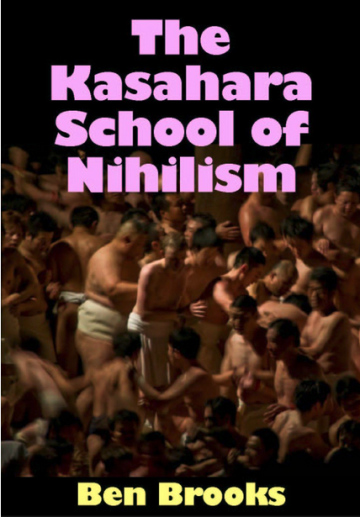REVIEW: Ben Brooks' THE KASAHARA SCHOOL OF NIHILISM
In The Wind-Up Bird Chronicle by Haruki Murakami, May Kasahara is a teenage girl with an amoral sense of humor. When her neighbor, the protagonist, descends into an abandoned well to contemplate his wife's disappearance, she pulls up the rope ladder that is his only means of escape. He asks her why she did it, and she replies, none-too-comfortingly, “Why not?” then points out, “You might die down there, depending on my mood.” At the end of the scene, she puts the cover back over the top of the well, leaving him in the dark -- both literally and metaphorically, as he has no way of guessing her intentions.
May Kasahara is a disturbing character not just because of her actions, but because of the straightforward, even lighthearted, way she carries them out. “You don't really believe me, do you, Mr. Wind-Up Bird?” she asks. “You think I couldn't do anything so cruel.” She is familiar to us, recognizable as a teenage type, even as someone with whom we can identify, and that makes the possibility that she's capable of such a profoundly nihilistic act truly chilling.
In Ben Brooks' The Kasahara School of Nihilism, we meet teenage characters whose disaffection and alienation from others are most likely modeled on May's (Brooks discusses Murakami's influence on his work here). There's Chizuko Sato, the target of the Japanese equivalent of “yo mama” jokes in the classroom (“her mum was a goat and her dad was a pig”), who comforts herself with friendlier faces drawn in ink on her hands; Hoshi, who slides one- or two-word anonymous messages into other people's letterboxes and absorbs herself in romantic sexual fantasies; Nobu, who compensates for his mother's suicide by drawing “a wife” on his wall and sleeping beneath it in mute adoration; Kenzabuto, whose similarly self-destructive mother appears to be drinking herself to death, and who spends a lot of time by himself, staring at the empty microwave thinking things like, “Cars crash. Children die,” and “Little Kenzabuto, It is just you now.” Yet, for all their emptiness, and the pyrotechnic stunts of language and typography employed to evoke that emptiness, not one of these characters managed to startle, perturb, or otherwise move me to the extent May Kasahara did in even a single scene of The Wind-Up Bird Chronicle.
Part of this may be due to the inherently static nature of this story. Writers like Mark Z. Danielewski (in the magnificent House of Leaves) and Steven Hall (in the pulpy, fun Raw Shark Texts) have discovered ways of using innovative typography to drive story forward, sometimes by highlighting the mental states and obsessions of the characters, sometimes by imitating the techniques of film. Yet in this “novel” (as the publisher refers to it – I'd describe it as either a novella or a narrative poem), the plentiful empty space on the page is just that: a blank left for the reader to fill in. Again and again, this fiction steps from its knife's edge of plotline into total incomprehensibility. The characters' streams of consciousness sound like they were extracted after a heavy dosing of sodium amytal ("Motivation for clean clothes inside a wax sphere of crippled needles and crushed ochre," we find in the second section devoted to Hoshi; "We are bricks. Despair is beauty," we hear from Kenzabuto) but much of the in-scene action is hardly more coherent.
In one episode that that may or may not be a fantasy, a Jesuit priest arrives on the schoolyard, brandishing a gun: " 'Lets get anal' he laughters" (sic), at which point two policemen attack him and carry him away on their backs, as he "thrusts solemnly into their spines with his eager penis. Monumental phallus. The companion of my childhood lover." As this happens in one of Hoshi's sections, I assume that the "my" refers to her, but beyond that the exact meaning of this line escapes me (who is the lover that she's referring to?), and the scene, taken as a whole, is a morass of What the Hell Just Happened. When every line strains so mightily to stand out -- with inflated language and placement on the page -- the effect is that none of them do.
Moreover, instead of pulling us forward, they leave us stranded, stuck, sometimes in contemplation but more often in confusion.Even the repeat appearances of a god-like bear didn't pique my curiosity enough to keep me turning the pages. Although the book lurches closest to humor and charm in this creature's company (in one nice exchange, the teens' schoolteacher, feeling insignificant, complains, "Sometimes I shrink into my own palm," to which the bear commiserates, "Paw"), these moments arise out of such a jumbled context that the any poignant absurdity is lost. Who is the bear? What is his significance, both as an allusion and for the characters? According to Wikipedia, the Japanese Ainu celebrate a ritual midwinter "Bear Festival" when they capture a young cub -- is this the connection we're meant to be making? Or perhaps the bear is tied to the book's multiple references to the "Russian gods" -- the Nivkh in Russia also have a long history of worshipping the ursine. Or maybe it's both, or neither: when Nobu asks, "What is a bear?" the bear rambles about "ineffable feelings which exist between people," and sums it all up by saying with a shrug, "I am a bear."
In any case, deciphering this author's motivations is beyond my limited powers of comprehension. Or perhaps I should admit I just don't care. In The Wind-Up Bird Chronicle, only half of what made May Kasahara fascinating was the fact that she was mysterious and disaffected and that the reader didn't know what she would do next. The other half was the fact that she was ordinary, corporeal -- that she existed in a world like our own, and that her actions in that world had material consequences. Even if she believed in nothing, something existed all around her, and it was that friction with her environment that gave her life as a character. In The Kasahara School of Nihilism, though, things just happen, devoid of material consequences -- devoid even of material. No event, action, or image is anchored enough in specificity, in context, to exert a pull over anything else in the text. "He hasn't come to make me," Brooks repeats again and again, in a kind of refrain. Though I could not tell you whom the "he" and the "me" are supposed to designate, to my mind they certainly could refer to the author and his as-yet undefined cast of characters.
Ben Brooks is the author of the books Fences, also out from Fugue State Press, and An Island of Fifty, published by Mudluscious Press.

 Chandler Klang Smith's genre-bending novel The Sky Is Yours (Hogarth/Penguin RH, 2018) was listed as a best book of 2018 by The Wall Street Journal, New York Public Library, Locus, LitHub, Mental Floss, and NPR, which described it as "a wickedly satirical synthesis that underlines just how fractured our own realities can be during periods of fear, unrest, inequality and instability." Chandler has an MFA in creative writing from Columbia University. She has served twice as a juror for the Shirley Jackson Awards, worked in book publishing and as a ghostwriter, and currently teaches creative writing at Sarah Lawrence College.
Chandler Klang Smith's genre-bending novel The Sky Is Yours (Hogarth/Penguin RH, 2018) was listed as a best book of 2018 by The Wall Street Journal, New York Public Library, Locus, LitHub, Mental Floss, and NPR, which described it as "a wickedly satirical synthesis that underlines just how fractured our own realities can be during periods of fear, unrest, inequality and instability." Chandler has an MFA in creative writing from Columbia University. She has served twice as a juror for the Shirley Jackson Awards, worked in book publishing and as a ghostwriter, and currently teaches creative writing at Sarah Lawrence College. 